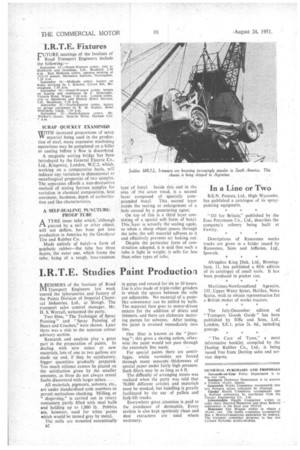I R.T.E. Studies Paint Production
Page 36

If you've noticed an error in this article please click here to report it so we can fix it.
UTEMBERS of the Institute of Road 1VL Transport Engineers last week toured the laboratories and factory of the Paints Division of Imperial Chemical Industries, Ltd., at Slough. The transport sales control manager, Mr. H. S. Worrall, welcomed the party.
Two films, "The Technique of Spray Painting" and "Spray Painting of Buses and Coaches," were shown. Later there was a visit to the separate colouradvisory section.
Research and analysis play a great part in the preparation of paints. In dealing with new mixes or new materials, lots of one to two gallons are made up and, if they be satisfactory, bigger quantities gradually prepared. Too much reliance cannot be placed on -the satisfaction given by the smaller amounts, as these do not always reveal faults discovered with larger mixes.
All materials, pigments, solvents, etc., are under standardized code numbers to permit meticulous checking. Milling, or " dispersing," is carried out in rotary containers partly filled with steel balls and holding up to 1,000 lb. Pebbles are, however, used for white paints which would be turned grey by metal.
The mills are mounted eccentrically 82 in gangs and rotated for six to 10 hours. Use is also made of triple-roller grinders in which the spaces between the rolls are adjustable. NO material of a pastelike consistency can be milled by balls. The material then goes to motor-driven mixers for the addition of driers and thinners, and there are elaborate metering pumps for solvents, After testing, the paint is strained immediately into tins.
One filter is known as the " jitterbug"; this gives a sieving action, otherwise the paint would not pass through the extremely fine mesh.
For special paints there are centrifuges, whilst varnishes are forced through many separate thicknesses of special paper under fairly high pressure. Such filters may be as long as 6 ft.
The difficulty of arranging stores was realized when the party was told that 70,000 different articles and materials must be stocked, but handling is greatly facilitated by the use of pallets and fork-lift trucks.
Everywhere great attention is paid to the avoidance of dermatitis. Every section is also kept spotlessly clean and dust extractors are used where necessary.




















































































